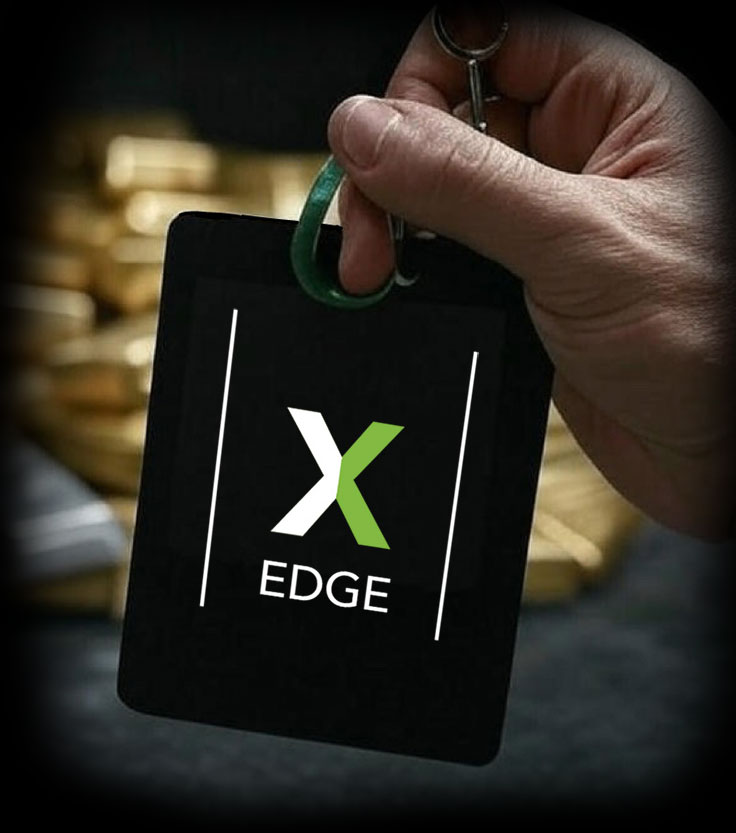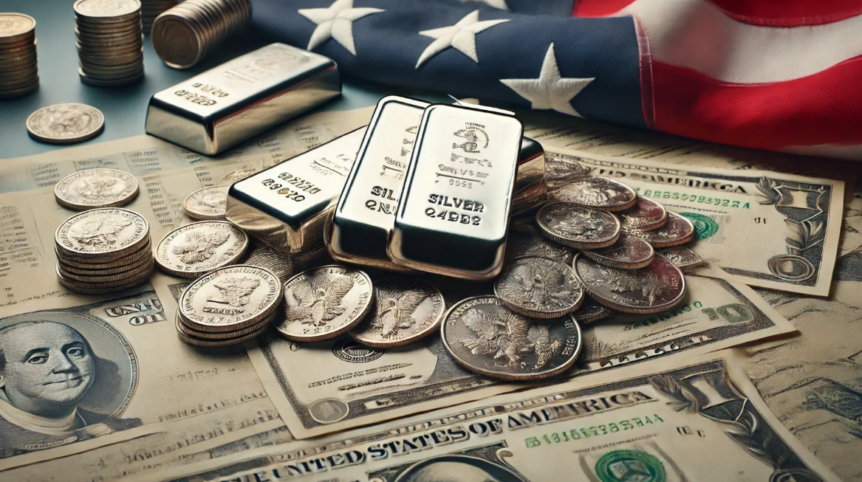In times of economic uncertainty, many investors turn to precious metals as a safe haven to protect their wealth. Among these metals, silver has always held a unique position. Known for its industrial uses as well as its role in currency, silver is often seen as a hedge against economic downturns. But what happens to silver if the economy undergoes a severe downturn? This article will explore the potential outcomes for silver in such a scenario and why it remains a crucial component of any diversified investment strategy.
Silver’s dual role as an industrial metal and a precious metal makes it a vital part of the global economy, contributing to both technology and wealth preservation.
| Key Takeaways |
|---|
| Historical crises, like the 2008 financial meltdown, demonstrate how silver prices can surge as investors seek refuge from economic instability. |
| A dollar collapse could drive silver prices to unprecedented highs, as it becomes a more accessible alternative to gold for hedging against US dollar currency devaluation. |
| OWNx fractional ownership offers an accessible way for investors to gradually build their silver holdings without committing large sums upfront. |
| A diversified strategy, including silver and other precious metals, can help investors manage risk and capitalize on different market dynamics during economic turmoil. |
| In a world without a stable US dollar, silver’s historical role as money could see a resurgence, further solidifying its importance in global wealth preservation. |
Understanding Silver’s Role in the Global Economy
Silver plays a significant role in the global economy, not just as a valuable commodity but also as a key component in various industries. Its conductivity and antibacterial properties make it essential in electronics, medical equipment, and solar energy production. These diverse applications mean that silver’s value is tied to both industrial demand and its status as a precious metal.
In the global economy, silver is often traded alongside gold, and its price movements are closely watched by investors. Unlike gold, which is primarily valued for its use in jewelry and as a store of value, silver’s industrial applications give it a dual role. This makes silver more volatile in price, as it is influenced by both economic growth (which drives industrial demand) and investor sentiment (which drives demand for precious metals during economic uncertainty).
The Impact of a Dollar Collapse on Silver Prices
A collapse of the US dollar, the world’s reserve currency, would have profound effects on silver prices. Historically, during financial crises like the Great Recession that followed the 2008 global financial system meltdown, silver saw significant price increases as investors sought refuge from economic instability. When the dollar weakens, silver prices tend to rise because it becomes cheaper for investors holding other currencies to buy silver.
In the event of a dollar collapse, where the dollar loses significant value or its status as the world’s reserve currency, silver could see a dramatic increase in price. Often referred to as the “poor man’s gold,” silver becomes an even more attractive option for those priced out of gold. As a more affordable precious metal, silver provides an accessible entry point for hedging against the devaluation of paper money, especially during hyperinflation or a loss of confidence in fiat currencies.
Moreover, a dollar collapse would likely lead to widespread panic selling in financial markets, further fueling demand for defensive assets like physical silver. The intrinsic value of silver, coupled with its physical presence, would make it an attractive option for preserving wealth during such a crisis. This increased demand could drive silver prices to unprecedented highs, solidifying its role as one of the most valuable assets in a portfolio during extreme economic instability.

Start buying precious metals at cost.
The Future of Silver Prices: Will Silver Hit $100 an Ounce?
Historically, silver prices have surged during periods of economic distress. For example, during the 1970s, silver experienced a significant price increase, driven by inflation and geopolitical instability. More recently, during the Great Recession, silver prices saw substantial gains as investors sought refuge in precious metals.
If the economy were to collapse today, a combination of factors could push silver well over the $100 mark. First, a US dollar collapse would likely erode confidence in all fiat currencies, leading to a rush into tangible assets like silver. Second, if industrial demand for silver remains steady despite the economic downturn, this could further drive prices up. Finally, speculative investment could play a major role, as traders and investors flock to silver in anticipation of further price increases.
While predicting exact prices is difficult, the conditions created by an economic collapse could set the stage for silver to exceed $100 an ounce. However, it’s important to remember that silver’s price is influenced by various factors, including market sentiment, industrial demand, and broader economic conditions.
Silver’s Relationship with Other Precious Metals in a Dollar Collapse
Silver, like gold, platinum, and palladium, serves as a protective asset during economic crises, though each metal responds differently depending on the situation. If the dollar collapses, gold would likely lead as the primary store of value due to large investors and institutions seeking a safe haven, with silver following as smaller investors move their savings to a safer store of value. This close relationship means that when gold prices rise due to economic instability, silver and other precious metals often see similar increases.
Historically, the gold-to-silver ratio narrows during periods of economic distress, as silver’s price begins to catch up with gold. Similarly, silver can sometimes outpace platinum and palladium in percentage gains due to its lower starting price and greater volatility. If the dollar were to collapse, it’s likely that all these precious metals would see significant price increases, with silver potentially offering higher returns.
Investors hedging against a dollar collapse might consider a diversified strategy that includes silver alongside other precious metals. This approach not only spreads risk but also allows investors to capitalize on the different price dynamics of these metals during times of economic turmoil.
Investment Strategies: Protecting Wealth with Silver
In a world of economic uncertainty, protecting wealth becomes a top priority for many people. Silver offers several unique advantages that make it an attractive option for wealth preservation.
First, silver is a tangible asset, meaning it holds intrinsic value independent of any currency. This makes it a reliable store of wealth during times of high inflation or currency devaluation. Unlike paper assets, which can lose value rapidly in a financial crisis, physical silver retains its worth, providing a hedge against economic instability.
Second, silver’s dual role as both an industrial metal and a precious metal means it benefits from diverse demand drivers. This makes silver less susceptible to the extreme price volatility that can affect other assets during economic downturns. For investors, this provides a level of security, knowing that silver’s value is underpinned by both its industrial uses and its status as a store of value.
To protect wealth with silver, some investors choose a diversified approach that includes both physical silver (such as coins and bullion) and silver-related investments (such as stocks of silver mining companies). While this strategy provides exposure to silver’s price movements and possible substantial gains, it is recommended that investors first secure ownership of the physical metal.
Silver Coins and Bullion as a Hedge During Economic Uncertainty
Physical silver, particularly in the form of coins and bullion, is one of the most direct ways to hedge against currency devaluation. When paper money loses value, tangible assets like silver become more valuable as they are not tied to any particular currency.
Coins, such as the American Silver Eagle or Canadian Silver Maple Leaf, are popular choices for investors looking to hold physical silver. These coins are widely recognized and easy to trade, making them a liquid asset even in times of economic distress. Moreover, their small denominations make them accessible to a wide range of investors, allowing for flexibility in buying and selling.
For those looking to maximize the number of ounces they own, OWNx offers an innovative solution through its fractional ownership scheme. This system allows investors to own portions of silver bars or coins, making silver investment more accessible to everyone, regardless of budget. You can gradually build your silver holdings by acquiring it through fractional ownership of the lowest premium product available – 1000 oz. bars, while still benefiting from the protection that physical silver offers against currency devaluation.
Both silver coins and bullion, whether owned outright or fractionally, provide a solid hedge against the risks associated with fiat currency devaluation. As the purchasing power of paper money declines, the value of silver typically rises, preserving the wealth of those who hold it. This makes physical silver, including fractional ownership options, an essential component of any strategy aimed at safeguarding wealth during economic instability.

Start buying precious metals at cost.
The Role of Silver in a World Without a Stable US Dollar
If the US dollar were to lose its status as the world’s reserve currency, the global financial system would undergo significant changes. In such a scenario, silver could play a vital role in the new financial order.
Historically, silver has been used as money in various cultures, and its intrinsic value has made it a reliable medium of exchange. In a world where the US dollar is no longer stable, silver could regain some of its historical monetary roles, especially in countries where trust in paper currencies has eroded.
Silver’s widespread use in industry, combined with its status as a precious metal, would likely see it rise in importance as an asset for wealth preservation. Investors and central banks alike might increase their holdings of silver as a way to diversify away from fiat currencies.
Moreover, in a post-dollar-collapse world, other countries might turn to silver as a stable store of value, particularly in regions with less access to gold. This could increase global demand for silver, driving prices higher and reinforcing its role as a cornerstone of wealth preservation.
Conclusion
Silver is a valuable asset in times of economic uncertainty. Whether the economy collapses, the dollar weakens, or currency devaluation becomes a reality, silver offers a reliable hedge against these risks. Its dual role as both an industrial metal and a precious metal ensures that silver will remain in demand, providing stability in a volatile world.
For investors looking to protect their wealth, silver provides multiple pathways to diversification and security. From physical silver coins and bullion to investments in silver mining companies, the options are varied and accessible. As we navigate an increasingly uncertain economic landscape, silver’s importance in a well-rounded investment strategy is likely to grow.
The potential for silver prices to reach new heights in a collapsing economy underscores its importance as a store of value. While predicting exact price levels is challenging, the conditions that could drive silver to $100 an ounce or more are grounded in historical precedent and current economic trends. By understanding silver’s role and preparing accordingly, investors can better safeguard their wealth against the uncertainties of the future..
FAQs
When the dollar collapses, silver prices typically increase as investors seek refuge in tangible assets, making silver a more attractive option for preserving purchasing power.
The global economy influences the demand for gold and silver, with economic instability often driving investors to these metals as a hedge against market uncertainty.
Yes, during a banking crisis, the demand for silver often rises as investors look for secure investments, leading to potential price increases due to the metal’s intrinsic value.
Lower interest rates typically boost silver prices by making non-yielding assets like silver more appealing compared to interest-bearing investments.
Given current economic uncertainties and potential dollar collapses, silver is considered a solid investment for the near future, particularly for those looking to diversify their portfolios with physical assets like silver and gold.
Silver miners will be essential for maintaining the supply of silver in a world where investment demand is increasing rapidly. The financial stability of miners and their capital and balance sheets will determine if they will remain able to operate in a world where currencies are in significant flux. Doing your due diligence before investing in any silver miner is a must.
The silver content in coins and bullion directly impacts their value, especially during economic downturns when physical silver is in high demand as a hedge against currency devaluation.
